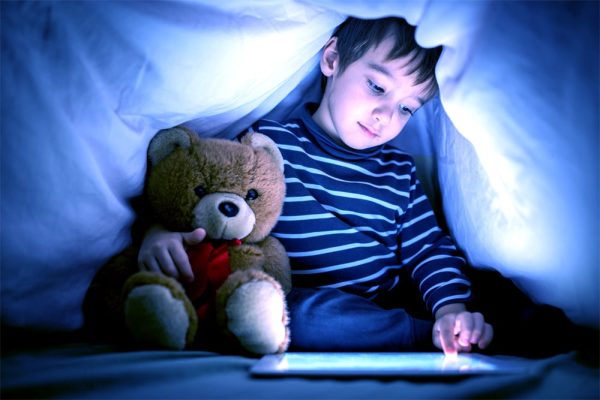Your cart is currently empty!

Why Blue Light is Bad for Kids: Blue Light Glasses & How to Protect Children from Digital Screens
Last Updated on October 4, 2023

There are few things that children of the 21st century like to hear less than being told they need to put the phone or tablet away.
The average American kid (or teenager) would happily scroll or click away until the moments before they go to sleep, if left to their own devices (see what happened when this family did an experiment with their children by giving them a weekend without technology limits!).
However, there’s good reason to make sure our children don’t fall into this pattern.
In a recent article, we talked about blue light (high-energy visible, or HEV light) emitted from the screens of computers, TVs and mobile devices and the effects it can have on our eyes.
Kids and adolescents are actually more vulnerable to the effects of blue light than any other age group.
This is for two reasons: their eyes haven’t had enough time to develop proper protection, and they have greater sleep needs than adults do.
Blue Light is Worse for the Eyes of Children
As we grow older, the lenses of our eyes gradually begin to yellow. This crystalline lens protects the retina. Though this might sound unhealthy, it actually serves as a natural defense against UV damage from the sun’s rays and other sources of shorter-wavelength light.
By age 20, our eyes have developed enough yellow pigment to absorb an adequate amount of blue light, which keeps it from reaching (and damaging) our retinas.
In contrast, the retina of younger eyes take in far more blue light due to a clearer crystalline lens.
The light emitted by digital screens is, of course, much less intense than the light given off by the sun, but it still has potential to cause harm, particularly when we stare directly at the sources for hours each day.
Studies:
Laboratory studies on rodent and primates have shown that direct retinal exposure to bright blue light for extended time periods accelerates rates of RPE (the pigmented cell layer that nourishes retinal visual cells) and photoreceptor death.
According to the American Optometric Association, visible blue light “can be absorbed by the retinal pigment epithelium (RPE) and certain photoreceptors (convert light into signals understood by the brain), generating localized oxidative and thermal stress. Oxidative stress has been shown to lead to a variety of eye diseases, including macular degeneration.
A study from the University of Toledo found evidence that blue light from digital devices transforms vital molecules in the eye’s retina into cell killers. They discovered that blue light, in particular, encouraged the accumulation of lipofuscins (a type of pigment associated with aging and cell damage), which are known to cause cytotoxicity of the retina. These poisonous by-products of blue light exposure inhibit the cells’ ability to regulate key processes, leading to an imbalance of calcium within the cell, changes in cell shape, and greater rates of cell death.
In the long term, these cytotoxic molecules can cause large amounts of the retina’s photoreceptor cells to die off, leaving us with steadily worsening vision and possibly even blindness. This disease is termed macular degeneration, and while it typically starts in a person’s fifties or older, frequent exposure to light that has such a damaging effect on our eyes might lower that age significantly.
Macular degeneration has no cure–as Kasun Ratnayake, a Ph.D. student researcher comments, “Photoreceptor cells do not regenerate in the eye. When they’re dead, they’re dead for good.”
We can safely assume that the light given off by our digital devices is not doing any favors to our eye health. For children, who simply haven’t lived long enough to develop natural protection, the danger posed is even greater.
Too Much Blue Light Leads to Sleepless Nights
Blue light–both in the form of sunlight and light from electronic screens–heavily influences our circadian rhythm, or sleep-wake cycle.
When blue light is taken in by our eyes, it sends a signal to our brain to suppress the production of melatonin, the hormone responsible for regulating our sleep. This is why we might have a harder time falling (and staying) asleep if we spend time watching TV or checking emails right before bed–low levels of melatonin make it very difficult for the body to “sense” that it’s time for bed.
Several studies looking at people exposed to blue-rich lights from artificial lighting or screens indicate that even very low exposure to blue-rich light in the evening delays or inhibits nocturnal melatonin synthesis, impacting your circadian clock.
Though adults and kids physically respond to blue light in the same way, kids will likely be more affected by negative consequences when their sleep rhythms are frequently disrupted.
This stems from the fact that kids need more sleep than adults do. According to the Sleep Foundation, this is how our sleep needs change as we age: Ideally, preschoolers (ages 3-5) should be getting 10-13 hours per day (including naps), school-aged children (ages 6-13) should be getting 9-11 hours, and teens (ages 14-17) should get 8-10 hours. By the time we reach adulthood, our sleep needs have decreased to 7-9 hours. So, excessive amounts of blue light are more likely to cut into sleep time for younger children.
This is unfortunate, as it’s no secret that adults are better at handling sleep deprivation than kids are–and explosive temper tantrums are just the beginning. Shalini Paruthi, a doctor that specializes in pediatric sleep disorders, describes a few of the ways children are impacted by poor or insufficient sleep:
“Lack of sleep is known to cause poor attention, worse grades, school absences, poor social interactions, irritability and crankiness, depression, increased car crashes, and increased risk-taking behaviors.
Specifically, research studies have shown that shorter sleep durations are associated with inattention, poor decision-making, and decreased memory, all of which can affect academic achievement. Small decreases in the total amount of sleep, even by just an hour less per night, can cause negative cognitive performance.”
This study published last year by a Harvard pediatrician found that children who are sleep-deprived in their younger years are at greater risk of developing poor neurobehavioral function in mid-childhood (around age 7).
There are other physical effects too; decreased immune system function, poor athletic performance, hormonal changes, and increased risk of obesity are some of the problems likely to spring up when a child isn’t able to get the sleep he or she needs.
Though adults also experience a drop in cognitive function when they’re not sleeping well, it is not as severe. And children are worse off when lacking sleep because they’re at a time in life when learning and cognitive development are the most critical–they’re constantly taking in information about the world around them.
If they’re chronically getting insufficient rest, the resulting drop in cognitive performance during these important years will likely have long-term impacts on their ability to learn and retain new things, problem-solve, and focus their attention.
Learn More About Blue Light
How to Protect Your Kids From Blue Light

Though our kids’ eyes may light up when they are handed the tablet so they can play their favorite game or watch YouTube videos, and our teenagers are perfectly content spending hours on social media, it’s crucial that steps be taken to counter their inherent vulnerability to the effects of blue light.
Most children are delighted by devices like iPads and TVs the moment they’ve been introduced to them, and it’s unrealistic to suggest that they shouldn’t use these electronics at all.
Thankfully, the simple measures below can make them a safer source of entertainment.
1. Set Boundaries
The first strategy all-around is to limit your kids’ use of mobile phones, laptops, and anything with a screen that emits blue light.
The American Academy of Pediatrics has recommended that children 2-5 years old should be getting at most 1 hour of entertainment-based screen time, and infants and children under two years old shouldn’t be using devices with screens at all.
In the past, it was recommended that kids 6 and older got no more than two hours daily; the new guidelines let parents choose an appropriate limit that works for their family, but say that it should be consistent, and that screen time should never take priority over sleep, physical activity, and social interaction.
Setting limits on use of digital devices is especially important in the hours before bed–it’s best to keep your children off them entirely for at least two hours before bedtime.
2. Blue Light Glasses for Kids
If you have difficulty compromising with your children about the amount of time they spend with screens, consider having them wear blue light blocking glasses for kids to minimize any harm done.
These glasses have special orange-tinted lenses that filter out blue light, and this pair is made specifically for children.
3. Dial Down the Source
You can reduce the intensity and amount of blue light that is given off by the devices your family use.
One of the simplest ways to do this is to turn the brightness down to the lowest setting at which your kids can still see comfortably (you may find that you experience less eye strain after doing this, too!).
Set firm rules about never using screens in an otherwise dark room.
To go one step further, you can download programs and apps for your personal devices that shift your screen backlighting towards the yellow/warm end of the color spectrum (check out f.lux and Iris). This type of light is much easier on the eyes and does not disrupt sleep the way blue light does.
Some mobile phones even have a “night shift” option built in, and you can set it to automatically transition to warmer lighting when evening comes. In fact, you can activate this feature all the time if you choose.
4. Set the Bedroom up for Success
If your children use digital devices frequently and have difficulty winding down before bed, consider replacing the light sources in their bedrooms with warmer colored lighting or less bright light in general.
When it’s time for bed, a completely darkened room is best (if they’re comfortable without a nightlight). Also, make sure that mobile phones and laptops don’t stay in their rooms at night, so they’re not tempted to do any late-night browsing.
Related Posts
None found



























